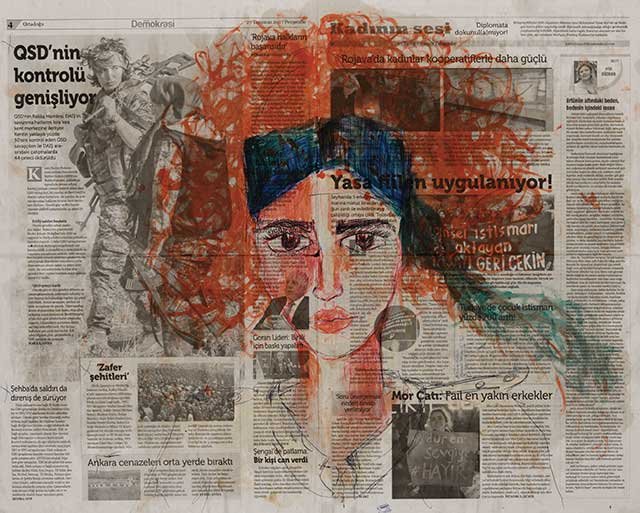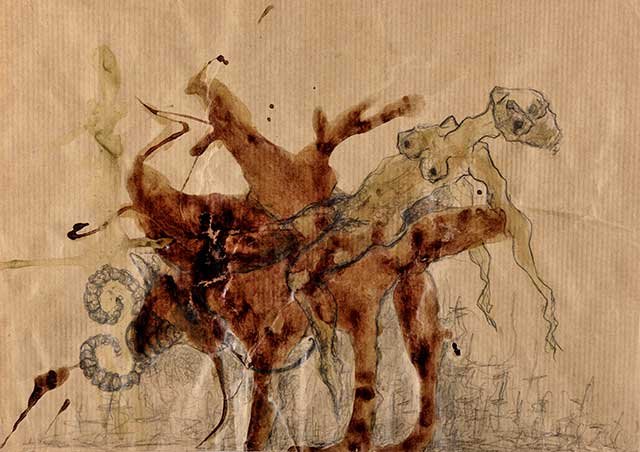Zehra Dogan on Xwebûn, Revolutionary Art and Resisting Borders.
“And I was terrified” Zehra tells me over zoom, she leans into her phone screen as she lets me in on this. Sat in a park in Berlin, on this particular Tuesday, I am once again admiring her cutting honesty - how viciously emotional she is and how this makes her even more powerful. This particular memory she is relaying to me, is about when she was arrested before being sent to prison. Under torture, many people gave confidential information regarding their friends, Zehra says “I knew how revolutionary, how forward thinking these people were, how honest they were…I was paralysed by the fear of what I could say when under police torture, especially considering how honourable my friends who have up information were”
In 2017, Zehra Doğan was sentenced to 2 years, 9 months and 22 days of prison by the Turkish state for her art work, which was deemed as ‘terrorist propaganda’ which has become a blanket term the Turkish state can arm themselves with in order to continue their baseless and undemocratic practices. Zehra’s work has been exhibited all around the world in places such as London, Berlin, Milano, Slemani, Zurich, New Jersey and Istanbul. Her graphic novel Prison n°5 was published in 2021 and in 2018 she was selected to be an honorary member of PEN international.
Zehra and I discuss if she sees her art as a form of political resistance. Raised in Amed (North Kurdistan), Zehra tells me how she was not given any choice of - “to be or not to be political…I was raised in a place where we saw people being killed right in front of our eyes…children knew what prison was…what happened under torture…no one told us to ‘get up and be political’ we just soaked it all up…it became intertwined with our childhood identities”. Undoubtedly, Zehra is a political woman, all of her artwork is set up in the context of her identity and the identities of those around her. It is clear to me that Zehra’s art leaves space for thought and interpretation. She doesn’t consider herself to be a representative figure for anyone, this would “put up walls around the artwork…make you landlock yourself off from a lot of stories, identities and histories”.
The artwork depicting of the devastation of Nusaybin that landed Zehra Dogan in Turkish prison.
“I don’t know borders, I don’t understand the boundaries of countries, because we are stateless…we have been cut into four pieces [by Iraq, Turkey, Iran and Syria] we know these borders, we recognise these…” for Zehra, her marginality is an advantage, a valuable resource which she uses to understand her multifaceted identity. We discuss Xwebûn, Xwe meaning ‘Self’ and Bûn meaning ‘To be’. Zehra asks me “How many Xwe do we have as humans?...I cannot say I am only Zehra, I have so many identities occupying space inside me” this is reflected in her art work time and time again; especially through her use of materials. During her time in prison, Zehra had to look within herself and her own body to produce her art. She was not allowed art materials, so she resorted to using hair, nails, and menstruation blood. In prison, she also cleansed herself from the concept of Biricilik (Turkish word for ‘Singularity’ an idea which liberalism and capitalism have taught us. In prison, she found herself turning to collective artistry. For Zehra, “True, revolutionary art centres Bihevrebûn (togetherness)... the culture of resistance is not a lonesome, singular thing” She is known for using her menstruation blood for her art work, in fact this was the idea of her prison friends and drawing on chocolate wrappers or using fruit peel was done before Zehra; she rejects the idea that she is the first and sole creator of such things.
Zehra using her menstrual blood was labelled as ‘disgusting’ by the prison guards, she tells me that she didn’t have the will left in her to explain to them that menstrual blood was considered sacred in history, in fact it is commonly used by tribal and aboriginal people to heal wounds. This is of course, a conversation that many people, let alone Turkish police, are not patient enough to listen to. “The truly ‘disgusting’ thing was not my blood, it was the conditions under which we were being kept in, it was the reasons for my 2 year 9 month and 22 day sentence” Zehra’s utilisation of her menstrual blood was a protest - against the disgusting state, by using something socially perceived as disgusting she was able to achieve her objective: resistance.
A wall mural by Banksy in New York in 2019 drawing attention to the imprisonment of Zehra Doğan.
Photo by Timothy A. Clary/AFP/Getty Images.
Towards the end of our conversation, I couldn’t resist the urge to ask Zehra for one piece of advice she would give to me. After much thought, she told me “When a child cries, we prevent the child from dealing with themselves, we try and make the child forget their sadness, their anger, their frustration, we shove a sparkly toy into their hands or we do crazy dance moves to make them laugh…we prevent the child from looking inside themselves. When you are in a state of confusion, at a crossroads, standing at the neck of a bridge, do not look outside of yourself…do not allow people to serve you with things to stop you from crying” I know Zehra’s words will stay with me for years to come, she is Kurdish woman who I look up to - not just because of her persistence to create art even in prison where it was forbidden, but because she is secure enough in herself to tell me about her fears. I view Zehra’s artwork to be a manifestation of her kaleidoscopic and multifaceted identity - ever changing and immutable.










